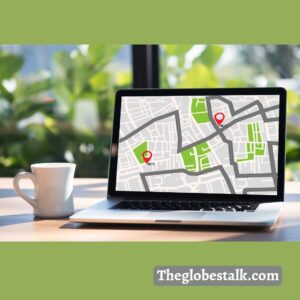In the last article, we got to know about the 3D model of the Earth. Can the Earth be represented as a 2D model or a drawing? Can smaller parts of the Earth be studied in detail with some drawings? Let us dive deep into the question.
A globe is a very useful thing when studying the Earth as a whole. But what would happen if we want to study just a small portion of it like a country, ocean, city or a state. The globe cannot show such small details. At this moment, Maps come to our rescue. A Map is a drawing or representation of the Earth’s surface or a part of it that is drawn on a flat surface according to a scale.
Maps are a simple representation of the world in a visual way. They show the size and shapes of countries, states and distances between places. They also show the various settlement patterns. Smaller maps can depict houses and streets in a neighbourhood also.
Uses of Maps

Maps are quite useful for us in several situations such as:
- Scientists use maps to study weather, to prepare the weather forecasts of a place, state or country.
- Planners use maps to decide the locations of hospitals, parks or libraries to keep them in a central location.
- Travellers use maps to travel across different places.
A specific map shows some features of a place and another map shows the features of another area. A collection of maps is known as an Atlas. They are of different sizes, drawn on different scales.
Cartography –
The study and art of making maps are known as Cartography and the people who make maps are called Cartographers.
Types of Maps:-
The maps are classified based on their functions. The types of maps are:
Political Maps –
A political map shows the divisions of a continent or country. They show the cities, towns, villages, states and countries with their boundaries.
Physical Maps –
These maps show the natural features of an area such as soils, topography, rainfall, weather and climate, vegetation, relief, oceans, seas, mountains, plains, rivers and many more.
Thematic Maps –
These type of maps focus on one theme or topic. They display the patterns on the surface. Thematic maps mainly show road information about roads, rainfall patterns, forest, industries etc.
Components of Maps
There are some features or components of maps that are included in every map. These are Scale, Symbols, Grid, Direction and Legend.
1. Scale
The main function of a map is to reduce the area and show a specific region as a drawing. The reducing of area needs to be done very carefully such that the distance between the two places is real. This is done by choosing a suitable scale. A Scale is the ratio of the actual distance on the ground and the distance on the map.
For example, the distance between your home and the playground is 5 km. if you show 5km by 1 cm on the map then the scale of your map would be 1 cm = 5 km. Distances between two places can easily be calculated when the scale of the map is known to us.
A scale of a map depends on the area that is represented. Based on the area shown by a map, they can be divided as:
Large scale map –
When a small area is shown on a map such as a village or a town, then a larger scale is used. These types of maps are large scale maps.
Small scale map –
When a larger portion of land is represented such as a continent or country, a small scale is used like 5cm for 500km. These maps are Small scale maps.
Larger scale maps show better details as compared to small scale maps. Today, maps are digital which can be zoomed in and out to see more details.
2. Symbols
The various features of a map such as buildings, roads, bridges, railways, oceans and boundaries are shown with the help of symbols such as shades, colours, lines, letters and pictures. They allow easy understanding and reading of maps. They help a lot in knowing what is located in a particular area. Maps have universal symbols that are understood by everyone. These symbols are known as Conventional symbols.
For example, black dots indicate cities, lines represent boundaries, roads, highways and rivers. The green colour represents forests and blue is for water.
3. Grids
Many maps include a grid pattern or lines that create squares or rectangles on the map. They help in locating places on the map. These lines are the latitudes and longitudes. The crossing of them called coordinates, help in finding the location of a place.
4. Direction
Most of the maps show an arrow with the letter N at the top of it. This is the north line and shows the north direction. Knowing the north makes it easier to find the other 3 major directions namely East, West and South. These 4 major directions are called the cardinal points and the directions between them – North East, South East, North West and South West are the intermediate directions.
5. Legend
It is the explanation of the symbols that are used on the map. It includes the symbol and the description of what it describes.
How are maps made?
Mapmakers or cartographers before making a map think about the area and information they want to display on the map. They consider the purpose and audience of the map and then decide the scale and details of the map.
Previously, maps were made by hand but with modern technology, they are now made by computers. The details of the map are entered into the computer and then the map is made by the computer.
What are Sketches and Plans?
A sketch is a drawing based on memory and observation and not to scale. These are made to show some rough details of a place with respect to other places. For example, you may draw a rough drawing to show the way to your house. This rough drawing is a sketch map.
A Plan is a drawing of a small area done on a large scale. Large scale maps show more details but sometimes we may want to know the length and breadth of a room which can be shown easily by a plan.
Did You Know?
In 2000, a map of the night sky was discovered in the cave complex in France. The map is believed to be more than 16,500 years old. This tells that the roots of map-making go back to a time even thought of.
Why are maps even required?
In a world where a GPS is ruling, the question arises why are maps even required? Some of the reasons why maps are so important are:
- They help to gain important life skills
- They are the basic functional tools.
- When you are in danger, maps can be a life-saver.
- They are proofs of our history.
Now when we have known everything important about maps, we would like to test the knowledge you have gained. Below are some interesting and simple based on maps.
